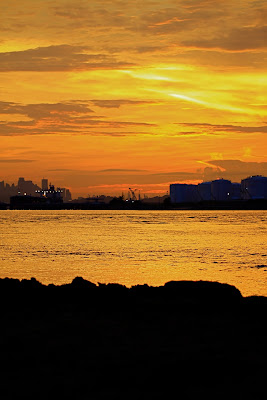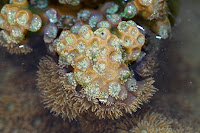 Today, we visited Terembu Pempang Laut which is part of a cluster of submerged reefs located between Jurong Island to the north, and Pulau Sudong and Pulau Salu to the South. This reef was a first for all of us, Ria included, so there was definitely some excitement about venturing into the unknown, not knowing what we would see.
Today, we visited Terembu Pempang Laut which is part of a cluster of submerged reefs located between Jurong Island to the north, and Pulau Sudong and Pulau Salu to the South. This reef was a first for all of us, Ria included, so there was definitely some excitement about venturing into the unknown, not knowing what we would see. We set off from Keppel Marina amidst the darkness at about 6am but it wasn't long before first light peeked through the clouds in the distance. By the time we got to the terumbu, the sun began to reveal its glory in ways one can only imagine.



















The first thing we noticed upon reaching the terumbu was a golden sandbar cutting across the reef. This was a good sign insofar as landings were concerned. As the tide was still receding, we couldn't really make out just how large this reef was. But after wondering around for half an hour or so, I realised that this reef is huge. It might not be as long as Cyrene, but it is certainly a lot wider. The unusual thing about this reef is the fact that there are different 'terrains' in different parts of the reef. There are huge rock and inter-tidal pools throughout the reef. The northeast of the reef consists mainly sand, coral rubble and lots of sargassum in tidal pools. There are also lots of soft coral and anemones and some, particularly the leathery ones which are mostly bleached. The central area is rather sandy, flat and dry with some seagrass and a noticeable proliferation of bluish-green polyps. To the north and northwest lies the rocky edge of the reef and this is where most of the larger corals thrive. Sam saw at least 7 blue spotted fan rays in one very large tidal pool. The western side of the reef (left of the sandbar) is mostly flat and sandy with intertidal pools, some rock, coral, seagrass and quite a lot of sponges. Like the north, the west gets rockier nearer the edge and this is where Mei Lin found a burrowing giant clam firmly embedded in one of the rocks.









Compared to Sisters Island and Cyrene, this reef appeared to be more abundant with coral, both hard (Scleractinia) and soft (Alcyonacea).
The hard corals which I sighted included favids (Faviidae) , zoanthids , agarids (Agariciidae) , dendrophyllids (Dendrophylliidae) , euphyllids (Euphyllidae) , brain corals (Mussidae , pectinids (Pectiniidae) , poritids (Poritidae) , siderastreids (Siderastreidae and cabbage coral (Trachphyliidae) . Most of these appeared to be doing well and were showing their natural, sometimes luminescent colours. The zoanithids in particular, were a joy to photograph because many were caught in tide pools and hence, the polyps were not retracted.
















































There was also quite a large variety of soft coral especially leathery coral (Alcyoniidae) , though some were bleaching. There were also quite a lot of ascidians, sponges (Phyllum porifera) , flatworms , sea anemones (Actiniaria) , claims (Tridacna) and even a spider conch (Lambis lambis) .






















































And these were some of the coral which had bleached.







No comments:
Post a Comment